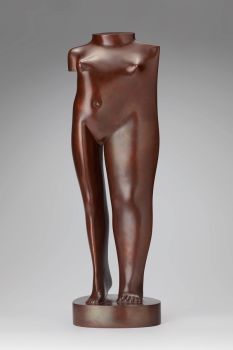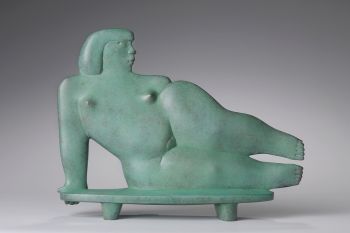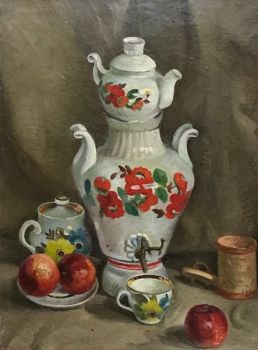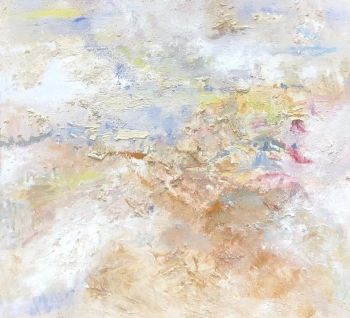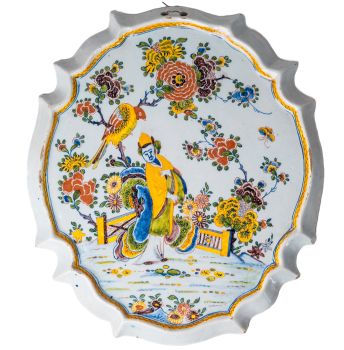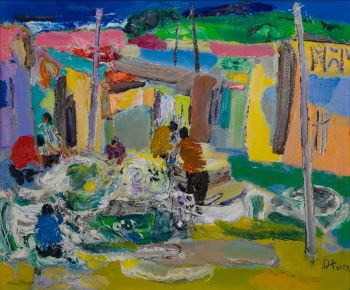Jaap Egmond – “IH 11-IH 12-IH 15-IH 16”, 1976 – relief: paper mache on wood, painted 1976
Jaap Egmond
BoisPapier machéPeindre
80 ⨯ 80 ⨯ 6 cm
ConditionGood
Prix sur demande
Van Kerkhoff Art
- Sur l'oeuvre d'artAn original relief – painted paper mache on wood – by the Dutch artist Jaap Egmond. Sculpted in May and June 1976. Signed, titled and dated by the artist. The relief consists of four pieces each signed, titled and dated on the reverse, merged together in the final artwork. In clockwise order (seen from the front) the quarters are titled “IH 11”, “IH 12”, “IH 15” and “IH 16”. Jaap Egmonds works are very mathematically driven – very much in contrast with his inspirer Jan Schoonhoven. This work is a prime example of this where the diagonally opposite quarters complement each other mathematically.
About Jaap Egmond
Jacob Johannes (Jaap) Egmond (New York City 1913 – Amstelveen 1997) was a Dutch artist, sculptor, painter, teacher and also a gifted pianist.
Born in New York as the son of a captain on the deep sea, moved back to the Netherlands with his family due to the threat of World War I. He grew up in Amsterdam and completed his training as a drawing teacher at the Rijksinstituut tot Opleiding van Tekenleraar from 1932 to 1936. In his early years, he also studied piano at the Amsterdam Conservatory of Music.
After his training, Egmond started working as a drawing teacher at several schools in Amsterdam in 1937, which was the beginning of a lifelong dedication to teaching. After the war, he taught at the Vossius Gymnasium and later at the Kweekschool and the Pedagogical Academy in Amsterdam. In collaboration with colleague Klaas de Poel, he developed a new teaching method for the Teacher Training College.
In 1969, Jaap Egmond settled as an artist in Amstelveen. During his career, he made abstract reliefs, strongly influenced by the work of Jan Schoonhoven, with which he became a representative of minimalism in the Netherlands in the 1970s and 1980s. His work, ranging from cardboard and paper to freestanding work in steel, was characterised by the play of light and shadow and monochromy.
Egmond exhibited his art from the early 1970s in galleries and art institutions. In the 1980s, he also experimented with total theatre, with his large plastics serving as sets for modern music performances, in collaboration with Wim de Ruiter.
Jaap Egmond is remembered as a constructivist artist, whose work is influenced by the Dutch Zero movement. His creations reflect a constant search for form, light and shadow, and monochromy, through which he left a lasting impact on Dutch art.
Signed
Signed, titled and dated by the artist on the reverse
Condition
Good original condition, some stains, small water-damage on the side.
Provenance
Borzo Gallery, Amsterdam
Dimensions
Artwork
Height 80 cm
Width 80 cm
Depth 6 cm - Sur l'artiste
Jacob Johannes (Jaap) Egmond (né le 31 août 1913 à New York et décédé le 26 novembre 1997 à Amstelveen) était un artiste néerlandais polyvalent, connu pour son travail de sculpteur, de peintre et d'enseignant, ainsi que pour ses compétences d'artiste. pianiste.
Egmond a apporté une contribution significative à l'éducation et à la théorie artistiques, en particulier dans les domaines de l'appréciation de l'art et de l'enseignement du dessin.
Son œuvre, composée principalement de reliefs abstraits, montre une nette affinité avec le travail de Jan Schoonhoven et le place comme une figure de proue du mouvement minimaliste aux Pays-Bas dans les années 1970 et 1980.
Né à New York en tant que fils d'un capitaine, Egmond est retourné avec sa famille aux Pays-Bas en raison de la menace de la Première Guerre mondiale, où il a grandi à Amsterdam. Entre 1932 et 1936, il suit une formation de professeur de dessin à l'Institut national pour la formation des professeurs de dessin d'Amsterdam, après avoir d'abord étudié le piano pendant un an au Conservatoire d'Amsterdam.
Après ses études, il débute comme professeur de dessin à Amsterdam en 1937, rôle qu'il remplira tout au long de sa carrière. Après la Seconde Guerre mondiale, il enseigne au Vossius Gymnasium et plus tard à l'Académie pédagogique d'Amsterdam, où il enseigne le dessin, le travail manuel et l'histoire de l'art.
Dans les années 1960, avec son collègue Klaas de Poel, il a développé une méthode d'enseignement innovante pour la Kweekschool, qui a été incluse dans divers manuels scolaires.
En 1969, Egmond s'installe comme artiste à Amstelveen, où il se concentre sur la création de centaines de reliefs en carton et en papier, suivis plus tard par des expériences avec l'acier et la peinture. Dans les années 1980, il travaille avec Wim de Ruiter sur des projets de théâtre total dans lesquels ses grandes sculptures constituent une toile de fond dynamique pour des performances musicales modernes.
Egmond, qui dans sa jeunesse hésitait entre une carrière de pianiste ou de professeur d'art, accompagna plus tard des chanteurs dans un cercle fermé. Il était marié à Joke Sprokkereef (1918-1986), enseignante, et ensemble ils eurent quatre enfants. La famille vivait à Amstelveen après la Seconde Guerre mondiale.
En tant qu'artiste, Egmond est considéré comme un constructiviste, fortement influencé par le mouvement néerlandais Zero. Son travail se caractérise par l'utilisation de la lumière et de l'ombre et une préférence pour la monochromie, avec laquelle il apporte une contribution unique à l'art moderne néerlandais.
Êtes-vous intéressé par l'achat de cette oeuvre?
Artwork details
Related artworks
- 1 - 4 / 24
- 1 - 4 / 24
- 1 - 4 / 24
Børge Mogensen
Teak wood “dropleaf” desk – Søborg Møbler, Denmark circa 19551950 - 1960
Prijs op aanvraagVan Kerkhoff Art
1 - 4 / 12







